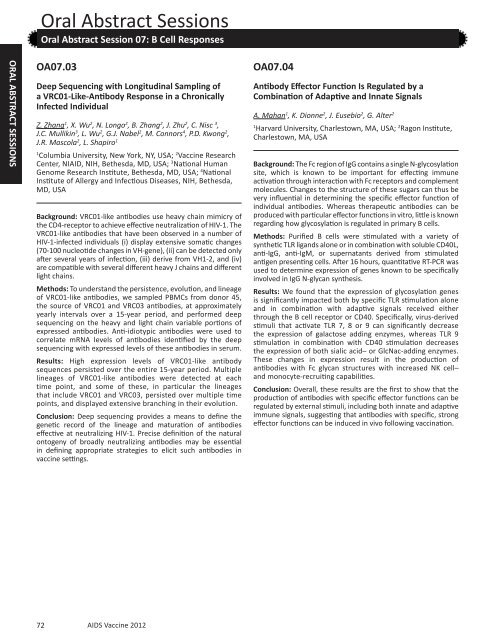Oral Abstract Session 01 - Global HIV Vaccine Enterprise
Oral Abstract Session 01 - Global HIV Vaccine Enterprise
Oral Abstract Session 01 - Global HIV Vaccine Enterprise
Create successful ePaper yourself
Turn your PDF publications into a flip-book with our unique Google optimized e-Paper software.
ORAL ABSTRACT SESSIONS<br />
72<br />
<strong>Oral</strong> <strong>Abstract</strong> <strong>Session</strong>s<br />
<strong>Oral</strong> <strong>Abstract</strong> <strong>Session</strong> 07: B Cell Responses<br />
OA07.03<br />
Deep Sequencing with Longitudinal Sampling of<br />
a VRC<strong>01</strong>-Like-Antibody Response in a Chronically<br />
Infected Individual<br />
Z. Zhang 1 , X. Wu 2 , N. Longo 2 , B. Zhang 2 , J. Zhu 2 , C. Nisc 3 ,<br />
J.C. Mullikin 3 , L. Wu 2 , G.J. Nabel 2 , M. Connors 4 , P.D. Kwong 2 ,<br />
J.R. Mascola 2 , L. Shapiro 1<br />
1 Columbia University, New York, NY, USA; 2 <strong>Vaccine</strong> Research<br />
Center, NIAID, NIH, Bethesda, MD, USA; 3 National Human<br />
Genome Research Institute, Bethesda, MD, USA; 4 National<br />
Institute of Allergy and Infectious Diseases, NIH, Bethesda,<br />
MD, USA<br />
Background: VRC<strong>01</strong>-like antibodies use heavy chain mimicry of<br />
the CD4-receptor to achieve effective neutralization of <strong>HIV</strong>-1. The<br />
VRC<strong>01</strong>-like antibodies that have been observed in a number of<br />
<strong>HIV</strong>-1-infected individuals (i) display extensive somatic changes<br />
(70-100 nucleotide changes in VH-gene), (ii) can be detected only<br />
after several years of infection, (iii) derive from VH1-2, and (iv)<br />
are compatible with several different heavy J chains and different<br />
light chains.<br />
Methods: To understand the persistence, evolution, and lineage<br />
of VRC<strong>01</strong>-like antibodies, we sampled PBMCs from donor 45,<br />
the source of VRC<strong>01</strong> and VRC03 antibodies, at approximately<br />
yearly intervals over a 15-year period, and performed deep<br />
sequencing on the heavy and light chain variable portions of<br />
expressed antibodies. Anti-idiotypic antibodies were used to<br />
correlate mRNA levels of antibodies identified by the deep<br />
sequencing with expressed levels of these antibodies in serum.<br />
Results: High expression levels of VRC<strong>01</strong>-like antibody<br />
sequences persisted over the entire 15-year period. Multiple<br />
lineages of VRC<strong>01</strong>-like antibodies were detected at each<br />
time point, and some of these, in particular the lineages<br />
that include VRC<strong>01</strong> and VRC03, persisted over multiple time<br />
points, and displayed extensive branching in their evolution.<br />
Conclusion: Deep sequencing provides a means to define the<br />
genetic record of the lineage and maturation of antibodies<br />
effective at neutralizing <strong>HIV</strong>-1. Precise definition of the natural<br />
ontogeny of broadly neutralizing antibodies may be essential<br />
in defining appropriate strategies to elicit such antibodies in<br />
vaccine settings.<br />
AIDS <strong>Vaccine</strong> 2<strong>01</strong>2<br />
OA07.04<br />
Antibody Effector Function Is Regulated by a<br />
Combination of Adaptive and Innate Signals<br />
A. Mahan 1 , K. Dionne 2 , J. Eusebio 2 , G. Alter 2<br />
1 Harvard University, Charlestown, MA, USA; 2 Ragon Institute,<br />
Charlestown, MA, USA<br />
Background: The Fc region of IgG contains a single N-glycosylation<br />
site, which is known to be important for effecting immune<br />
activation through interaction with Fc receptors and complement<br />
molecules. Changes to the structure of these sugars can thus be<br />
very influential in determining the specific effector function of<br />
individual antibodies. Whereas therapeutic antibodies can be<br />
produced with particular effector functions in vitro, little is known<br />
regarding how glycosylation is regulated in primary B cells.<br />
Methods: Purified B cells were stimulated with a variety of<br />
synthetic TLR ligands alone or in combination with soluble CD40L,<br />
anti-IgG, anti-IgM, or supernatants derived from stimulated<br />
antigen presenting cells. After 16 hours, quantitative RT-PCR was<br />
used to determine expression of genes known to be specifically<br />
involved in IgG N-glycan synthesis.<br />
Results: We found that the expression of glycosylation genes<br />
is significantly impacted both by specific TLR stimulation alone<br />
and in combination with adaptive signals received either<br />
through the B cell receptor or CD40. Specifically, virus-derived<br />
stimuli that activate TLR 7, 8 or 9 can significantly decrease<br />
the expression of galactose adding enzymes, whereas TLR 9<br />
stimulation in combination with CD40 stimulation decreases<br />
the expression of both sialic acid– or GlcNac-adding enzymes.<br />
These changes in expression result in the production of<br />
antibodies with Fc glycan structures with increased NK cell–<br />
and monocyte-recruiting capabilities.<br />
Conclusion: Overall, these results are the first to show that the<br />
production of antibodies with specific effector functions can be<br />
regulated by external stimuli, including both innate and adaptive<br />
immune signals, suggesting that antibodies with specific, strong<br />
effector functions can be induced in vivo following vaccination.


